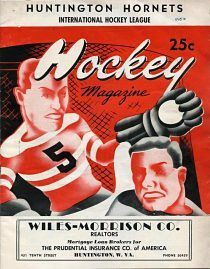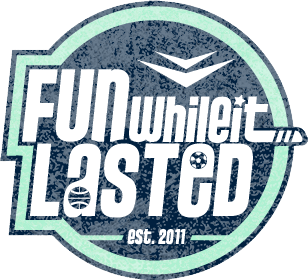International Hockey League (1956-1957)
Tombstone
Born: 1956 – The Grand Rapids Rockets relocate to Huntington, WV
Moved: June 1957 (Louisville Rebels)
First Game:
Last Game:
Turner Cup Championships: None
Arena
Marketing
Team Colors:
Ownership
Owner: Ernie Berg, et al.
Background
This entry comes to FWiL courtesy of West Virginia hockey historian Lenny Sundahl.
Some arenas don’t fall to the wrecking ball, but rather find their fate in a more utilitarian purpose. Back in the summer of 1956 the owners of the Stadium Arena in Grand Rapids, Michigan decided that their building was worth more as an Atlantic Mills department store. This had the effect of displacing the International Hockey League’s Grand Rapids Rockets, who found themselves under the caretaker governorship of Fort Wayne Komets GM Ernie Berg while the league searched for a new home for the team.
The search ended in the industrial/college town of Huntington, West Virginia. The city erected the Veterans Memorial Field House in 1950 for Marshall College (now University). The Fieldhouse was designed primarily for basketball. But the building also included a regulation size ice rink and hosted a handful of neutral site games for the Miami Valley Bruins in the early 1950’s. By 1956 the Bruins—now the Troy Bruins—were in the IHL alongside the Rockets, who would be rechristened the Huntington Hornets after the move to West Virginia.
On The Ice
The old Grand Rapids Rockets nucleus—including forward Ronnie Spong, and defenseman/bruiser Morris “Moose” Lallo—was supplemented by newcomers including forward Len Thornson, defenseman Roger Christian and player-coach Eddie Olson. So rushed was the move that the team resorted to wearing repurposed Fort Wayne Komets jerseys from the season before, with blue replacing black on the orange jerseys.
West Virginia not being traditional hockey territory, the crowds were slow to arrive for the new transplants. Attendance improved, however, as the Hornets proved to be a competitive entry in the six-team circuit. In the 1956-57 season—as in the season before and every season since they entered the IHL in 1952—the Cincinnati Mohawks ran away with the league, winning 50 of 60 games and leaving the other teams to fight for table scraps. Buoyed by the second-highest-scoring offense in the IHL—despite only having one player, Ronnie Spong, with over 20 goals on the season—the Hornets wound up in a four-team bottleneck for the final three playoff spots. The Indianapolis Chiefs finished with 57 points, while the Hornets, Toledo Mercurys, and Komets finished with 56 points each. The tiebreaker favored Huntington and Toledo, however, with 26 wins to Fort Wayne’s 25, and sending the Hornets into a matchup with the dominant Mohawks.
The teams took home wins through three games, but Cincinnati put Huntington’s season to an end with authority, taking a 6-1 win at the Field House to end the Hornets’ season. Huntington’s win in game two would make the only loss for the Mohawks in the postseason, as they swept Indianapolis to take their fifth consecutive Turner Cup.
As tight as things were on ice, off the ice was where the real action was. Ernie Berg, dissatisfied with early attendance, went looking for a new home for the team as early as December 1956, with his sights set on Evansville, Indiana, and that city’s new Roberts Stadium. The new building, however, lacked adequate space to put an ice rink. In the meantime, the team was put up for sale to attempt to generate local interest to keep the Hornets in Huntington. The first effort to save the Hornets was spearheaded by local promoter Dick Deutsch. Most notable for being the man who put Joe Louis in a wrestling ring, Deutsch had promoted boxing and wrestling matches in Huntington since coming to the area in 1941. Deutsch attempted to rally local investment through selling shares for $100, with a goal of $30,000; he fell short, raising only $22,000. A second attempt—at the lowered price of $22,000—was made by Huntington Jaycees president Luigi Narcise, but that fell short as well, and the decision to suspend operations was made in April 1957.
Two months, the IHL approved Louisville, Kentucky to replace Huntington for the 1957-58 IHL season. The re-named Louisville Rebels lasted three seasons, folding in 1960.
##
–Ronnie Spong would help lead the Louisville Rebels to a Turner Cup title in 1959 before that team folded in 1960. Spong would coach the Rebels’ final year, and go on to play the next four years—and coach the next 12—with the Greensboro Generals of the Eastern Hockey League making three straight finals appearances from 1962 to 1964 and winning a Patrick Kelly Cup in 1963.
–Moose Lallo went to the EHL’s Washington Presidents in 1957, and in 1960 became the coach of the IHL’s expansion Muskegon Zephyrs, where he coached all or part of the next 18 seasons, making 15 playoff appearances and winning two Turner Cups. As of 2012 he is retired and living in Florida.
–Roger Christian was named to the 1960 United States Olympic team that won gold at Squaw Valley. After his playing days ended, he and his brother Bill went into the hockey stick business, founding Christian Brothers, which became a leading hockey stick maker, supplying the 1980 Miracle on Ice team. He died in 2011.
–Len Thornson went to Fort Wayne in 1957, and began a string of eleven straight 30+ goal seasons before an eye injury shortened his career in 1968. Scoring 426 goals and finishing as the all-time scoring leader in the International Hockey League—his 1,252 points rank 10 ahead of Jock Callander when the league folded in 2001—Thornson was arguably one of the greatest players to never reach the NHL. He still resides in Fort Wayne.
–Hornets coach Eddie Olson went to Fort Wayne as well, coaching one more year in the IHL before retiring. He would go on to start the first youth hockey program in the St. Louis area, and was inducted into the U.S. Hockey Hall of Fame in 1977. He died in 1995.
–Huntington promoter Dick Deutsch died suddenly in 1964.
–Luigi Narcise brought occasional hockey games to the Field House throughout the 1960s, and attempted to bring the Toledo Mercurys to Huntington when arena conflicts arose in the 1959-60 season. He remained a popular and notable figure in Huntington society until his death in 2007.
Huntington Hornets Shop
Contains Affiliate Links
Huntington Hornets Retro T from Vintage Ice Hockey
Links
###



